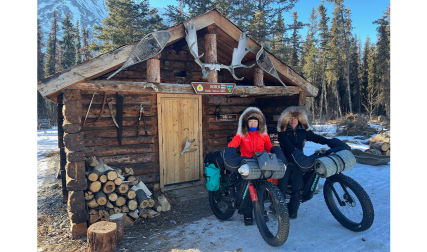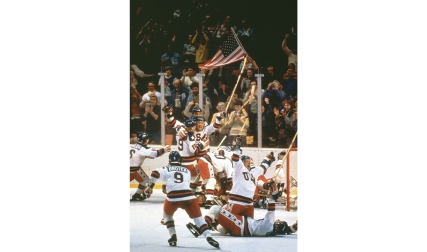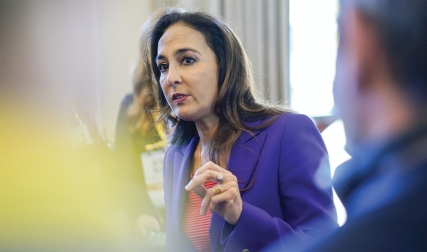Taking Sides
The Sept/Oct issue is your best work. Writing this note on the anniversary of Dr. King’s defining speech, I am moved that this issue of DAM was truly about “the content of their character.” The alumni/ae highlighted have made decisions and lived their lives at the sticking points of the most important personal issues of our time, and their triumphs are also triumphs for the College that opened up these possibilities for them. Bravo for reporting their stories.
Sam Ostrow ’67
Stamford, Connecticut
I would like to express my dismay at DAM’s promotion of homosexual lifestyle and choice by featuring in your most recent issue “Modern Family” about Rob Lasser ’89 and Lisa Baker ’89 and the “Continuing Ed” interview with Eric Fanning ’90.
I am fully aware that a portion of the United States has accepted nontraditional lifestyles and values. However, as a Christian with a traditional family, I feel it is neither appropriate nor in the interest of our alma mater for the alumni magazine to get involved in this controversial debate.
Richard Owen ’93
Brewster, New York
Shortchanged
Daniyal Mueenuddin ’86 [“The Storyteller,” Sept/Oct] wasn’t just a National Book Award finalist. He won the Story Prize and was a Pulitzer finalist as well.
Larry Dark
New York City
The Corbet Legend
The July/Aug story of Barry Corbet and how he turned a disability into a mission was truly inspiring [“Second Chapter,” July/Aug]. It brought to mind the story of Al Reich ’52. He was a golden young man at Dartmouth who was paralyzed in a freak accident a few years later. He spent the rest of his life leading the charge to make public access available for those with disabilities and to promote public awareness of their problems and opportunities as well. I wonder if there might be other encouraging stories among the alumni.
Dick Blum ’53
Cleveland, Ohio
Corbet was larger than life, but your article portrays a very human individual. It’s well written: a great account of an accomplished outdoors man seeking to find himself throughout his life. I don’t think he ever recovered from losing his friend Jake Breitenbach ’57.
I like to think I’m part of this Dartmouth tradition of finding meaning in the mountains.
Michael Childs ’72
Amherst, Massachusetts
I had just finished reading the recent article in Outside magazine about the 1963 Everest expedition when my DAM arrived. While I appreciated the entire story, I was inspired to write for the first time in 20-plus years because of the ending. My mom recently passed away after being diagnosed with lung cancer in March of 2013. Like Corbet, she chose not to do chemo and, when the time came, stopped eating and drinking as well. Although this choice is not right for everyone, in their circumstances where there
really is no cure, I so admire both Corbet and my mom for making a choice that really is a gift to their loved ones. We had time to say goodbye and most everything else that needed to be said and were not faced with the tragedy of having to watch her suffer for weeks or months.
Corbet and my mother are both beautiful models of a most graceful way to die. I can’t begin to put into words the sorrow of losing my mother and best friend, but I can say I hope when my time comes I have the courage to act as both of them did. They are heroes for both their accomplishments in life as well as their choices at the end. I also hope that reading about Corbet gives others a different and positive perspective on alternative end-of-life choices.
Heidi Turer Dormody ’91
Boulder, Colorado
Kudos on Broughton Coburn’s story of the lives of Barry Corbet. I feel I am somewhat qualified to heap praise on author and subject. I went from being awarded the Watson Trophy [given to Dartmouth’s outstanding athlete] in 1966 to becoming a quad in 1969 from shrapnel severing my spinal cord in a firefight in Vietnam.
Although I had support from many Dartmouth friends, my mother and father basically deserted me after being told I would be dead within five years.
VA rehab was a joke, as were the early phases of the Americans with Disabilities Act. I knew the pitfalls of being “super crip,” so I concentrated on family, work and staying alive. I still have my shoulders, can throw a baseball almost 60 feet, 6 inches and I roll three miles a day.
Coburn captured an amazing man and revealed his struggles and imperfections in coping with a truly drastic change in lifestyle.
Peter Barber ’66
Santa Rosa, California
I thought your July/Aug cover was suitable for framing—so I did. Corbet would cringe at the stylized cigarette commercial photo, but it faithfully captures his rugged spirit.
My freshman year roommate was Bob Sands ’59. Across the hall in South Mass, Corbet was the roommate of Frank Sands ’58 (who went on to fame and fortune with King Arthur Flour).
Corbet was one of the brightest and gutsiest people I have ever known. I admired him from Day One. On my only, short but memorable climb with Corbet—besides nearly freezing my ass off—I still recall asking him, “I thought you said there was a hand-hold here.” His reply: “You’ve got it!” Really?
Until your earlier article about Corbet and Breitenbach I never understood the derivation of the name “Effy” for the automobile they used (Fe2, ferrous oxide, or rust). I am not into naming vehicles, but my 1931 Ford pickup will henceforth be Effy also.
Thanks for the memories, and for keeping the remarkable spirit of Barry Corbet alive.
Robert L. Bartholomew ’59
Long Beach, California
Although your article about my late brother-in-law, Barry Corbet, places less emphasis on his incredible mountaineering exploits than on his even more incredible life after his paralysis, it nonetheless shows a very good picture of an extraordinary man.
I would argue with only one part of it. The footnote at the end of the article says that Barry got “mixed up in a classic clandestine boondoggle for the CIA.” In fact—as my sister Muffy, his ex-wife and lifelong friend, can verify—what Barry did was as heroic as the rest of his life. It involved leading 10 Sherpas to one of the highest peaks in the Himalayas to place an electronic device to monitor China. It was dangerous work and, of course, quite politically risky. The CIA thought so too and thereafter awarded Barry its gold medal, one of very few issued. CIA Director Allen Dulles took Barry to lunch and gave him the medal but never quite let go of it, saying that the mission was classified, and the medal would be his once the mission was declassified. A year before Barry died, a representative of the CIA came to Colorado and gave him the medal, which now resides at the American Alpine Museum in Boulder, Colorado. Hardly a boondoggle.
John French III ’55
New York City
Fifty years ago, when I worked for the advertising agency William Esty Co. in New York City, I was assigned to art direct the picture of Corbet that appeared on the cover of the July/Aug issue of DAM. The picture was staged for a Camel cigarette ad at Grand Teton National Park.
Richard Beatty, the photographer, and I flew to Jackson Hole, Wyoming, met Corbet and headed for the photo site. In order to have the Tetons behind him, we posed him on a rock ledge a half-mile or so from the mountains. It was an impressive shot, but stripping in the peak of Mount Everest later made it even more so.
It was customary then to add a cigarette in the mouth of the model to further associate rugged masculinity with smoking.
Incidentally, the Camel cigarette brand is owned by R.J. Reynolds Tobacco Co., not Phillip Morris. It was acquired about 1913, when smoking first became popular.
Doug Leigh ’46
Huntington, Connecticut
Let’s Be Rational
As an avid outdoorsman and resident of the beautiful state of Colorado, I share Bob Bauer ’82’s concerns about climate change and the future of our planet [“Letters,” July/Aug]. I am also employed in the oil and gas industry, which has helped drive U.S. CO2 emissions to 20-year lows while lowering America’s energy costs, greatly mitigating the effects of the recent recession. Dartmouth alumni, blessed with liberal educations and trained to think deeply about important issues, should be in the vanguard of an agnostic debate on energy. It does not serve our planet to deify or demonize coal, hydroelectric, oil, wind, natural gas or nuclear sources of energy, each of which has its pros and cons. Instead, let’s foster a rational discussion that eschews subjective moral imperatives and takes into account energy efficiency and density, prudent development, and access and affordability. After more than two decades of working in and thinking about the oil and gas business, I’m honored to be a part of it. We’re not perfect, though, and—back to the advertisement that sparked Mr. Bauer’s comments—we could benefit from a few more Dartmouth graduates who want to figure out how best to power the world.
Patrick Rutty ’88
Littleton, Colorado
I Beg to Differ
I take issue with the July/Aug letter from Mike Mosher ’77 about Nelson Rockefeller ’30. Comparing the Rockefeller family’s decision to destroy a mural by Diego Rivera in 1934 to the Taliban’s destruction of Afghanistan’s Bamiyan Buddha statues in 2001 is flawed parallelism. The murals were painted with Rockefeller family, not public, money. The Rockefellers could do—and did—what they thought was appropriate with their property.
However, the most disappointing news in the issue was the inclusion of a proposal to change the name of the College to Dartmouth University. Haven’t those intellectual elitists ever heard of the Dartmouth College case? You couldn’t take “Government 1” without reading it in the 1950s. Why include such a proposal the framers of the strategic plan had to know wouldn’t fly? It would alienate alumni, and I can’t imagine such a name change could help the recruiting of students. If keeping our name as Dartmouth College makes it more difficult to recruit faculty, maybe it will help eliminate candidates that wouldn’t be successful in a Dartmouth environment. The faculty shouldn’t try to sell what can’t be bought.
Jerry Scott ’59
Selbyville, Delaware
Screen Saver
With every dollar counting, was it necessary to spend money to pay to post Phil Hanlon’s picture on the big screen in Times Square [“Big Picture,” July/Aug]? While Dartmouth may have an account with PR Newswire that brings down the cost, the list price of $399 for exposure on the screen plus $250 for the photo of the moment represents money that could have been put to better use.
John Lippman ’71
Washington, D.C.
Catching Up
Having just read your profile of George William Rutler ’65 [“Father Figure,” Mar/Apr 2012] at dartmouthalumnimagazine.com, I am very much impressed by where he was on 9/11. He never once told that story of being at Ground Zero to his parishioners at the Church of Our Saviour, which I attended daily for five years. If only he had told that story in the words used in your article, so many would have seen him as he is, very human indeed, and not a “saint” or “saintly” priest, which at times makes a wall stand between persons.
Bonnie Joy Osborn
New York City




